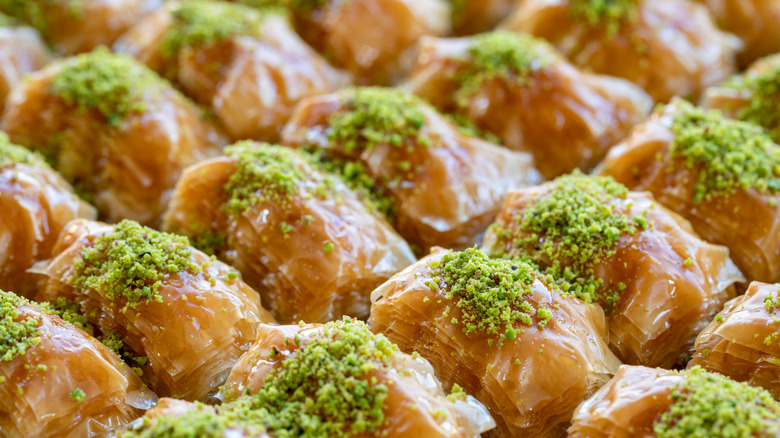The Simple Hack That Saves You Time When Making Baklava
Like all recipes that involve phyllo dough and centuries of tradition, mastering the perfect baklava is a high-effort undertaking with even higher rewards. The sticky and sweet dessert is certainly easy to eat — who could resist paper-thin layers of pastry filled with chopped nuts and doused in warm honey syrup? — but it's a labor of love to make at home.
There are many variations of baklava throughout the Middle East and the Mediterranean, according to Libanais Sweets. There's the traditional Turkish version topped with hazelnut kaymak, the Greek version whose 33 layers symbolize the life of Christ, and the Iranian version which is infused with rose water. But whichever way you slice it, every baklava recipe has you follow similar steps.
Food blogger and cookbook author Suzy Karadsheh shares her family's recipe for Greek-inspired baklava with an "Egyptian twist" on The Mediterranean Dish. After making the syrup and blitzing nuts and warm spices in a food processor, she has you assemble the phyllo dough. If you've ever worked with phyllo dough or puff pastry, you know that even the slightest breeze can tear a hole in its delicate form. Since baklava requires brushing each layer with butter, it's easy to dab your pastry brush a little too hard. Will some slight tears ruin your baklava? That's unlikely. But if you're a perfectionist who likes to save time, Yumna Jawad of Feel Good Foodie has a clever trick.
One fell swoop of butter
In an Instagram post, Yumna Jawad of Feel Good Foodie skips the part of the baklava process that involves dabbing each layer of phyllo dough in butter or ghee. Instead, she separates a package of phyllo dough into two equal halves, sandwiches her nut mixture between them, scores it accordingly, and pours melted clarified butter over the whole operation. Five minutes is enough time for the butter to soak into all the layers of dough, saving you oodles of precious time.
Jawad, who told Seen Magazine that she grew up eating Lebanese dishes in the Democratic Republic of the Congo, flavors her simple syrup with orange blossom water and lemon juice. She uses walnuts sweetened with granulated sugar for her filling, making for a classic version of the dish. But even if you choose a different recipe, Jawad's tip will come in handy when you don't have all day to labor over dessert.
From Istanbul to Ioannina
Many believe that the earliest form of baklava came about around 800 BC, during the Assyrian empire, according to Libainais Sweets. But just like moussaka (and countless other dishes), the dessert as we know it today most likely finds its touchstone in the Ottoman Empire — which comprised modern-day Turkey, among many other countries — around the 15th century, says Great British Chefs.
After a couple of centuries of experimentation, Great British Chefs adds baklava's final form was mastered in Istanbul's Topkapi Palace kitchens in the 17th century. The Sultan du jour allegedly had a sweet tooth and was a big fan of the dessert, so much so that he would dole out baklava to his soldiers on the 15th day of Ramadan. Libainais Sweets claims that Turkish baklava was inspired by the dessert's Persian origins, which led to its diamond-shaped pattern. But it's widely accepted that the Ottoman version is what inspired the similar variations that would trickle over to Greece and beyond.


